matlab求解线性回归,机器学习笔记(一)—— 线性回归问题与Matlab求解
给你多组数据集,例如给你很多房子的面积、房子距离市中心的距离、房子的价格,然后再给你一组面积、 距离,让你预测房价。这类问题称为回归问题。
回归问题(Regression) 是给定多个自变量、一个因变量以及代表它们之间关系的一些训练样本,来确定它们的关系。其中最简单的一类是线性回归(Linear Degression)。
线性回归函数的形式如下:
θj是我们要求的系数。接下来介绍一下求θ 的两种方法,梯度下降(Gradient Descent)和正规方程(Normal Rquation )。
1. 梯度下降法
描述:梯度下降法(Gradient descent)是一个一阶最优化算法,通常也称为最速下降法。 要使用梯度下降法找到一个函数的局部极小值,必须向函数上当前点对应梯度(或者是近似梯度)的反方向的规定步长距离点进行迭代搜索。如果相反地向梯度正方向迭代进行搜索,则会接近函数的局部极大值点;这个过程则被称为梯度上升法。
公式:
其中,J(θ) 称为代价函数(Cost Function )或损失函数(Loss Function), 用来量度预测结果和标准结果之间的误差,常见的有交叉熵,均方误差,平均绝对值误差等。在这里使用均方误差。α是学习速率,取值自定,一般取比较小的数,如0.03
( hθ(x) 是x经过待求的函数得出的结果,y(i) 是数据集中的结果)
公式(2)的旨在求出最小的θj,把代价函数J(θ)降到最小。它的原理是θ不停地迭代,减去θ对应的代价函数在x的偏导,如果偏导是正的,那么J(θ)在该方向单增,减去这个正数后θ变小,J(θ)也会跟着变小;反之,如果偏导是负的,J(θ)单减,原θ减负数,θ变大,J(θ)减小。无论怎样,J(θ)都朝着减小的方向变化。值得注意的是,如果学习速率α偏大,那么θ在做差的话可能减过头甚至得到的新J(θ)比原来还要大,而如果学习速率α偏小,那么花费的时间会变长。
梯度下降算法是一个不断迭代的过程,需要不断重复公式(2),直到J(θ)符合预期误差或者达到足够的迭代次数。
具体步骤如下:
step0: 初始化α,θ(任意值)和迭代次数;
step1:利用公式(3) ,求J(θ);
step2:利用公式(2),本次迭代的新θ;
step3:重复step1 - step2
2. 正规方程
利用正规方程可以直接计算计算θ,前提是(XTX)必须可逆
3. matlab实现
3.1 初始化参数
data = load(‘ex1data1.txt‘);
X= data(:, 1); y = data(:, 2);
m= length(y); %number of training examples
plotData(X, y)
X= [ones(m, 1), data(:,1)]; %Add a column of ones to x
theta= zeros(2, 1); %initialize fitting parameters%Some gradient descent settings
iterations= 1500;
alpha= 0.01;
3.2 计算代价函数
function J = computeCost(X, y, theta)
%COMPUTECOST Compute cost for linear regression
% J = COMPUTECOST(X, y, theta) computes the cost of using theta as the
% parameter for linear regression to fit the data points in X and y
% Initialize some useful values
m = length(y); % number of training examples
% You need to return the following variables correctly
J = 0;
% ====================== YOUR CODE HERE ======================
% Instructions: Compute the cost of a particular choice of theta
% You should set J to the cost.
predictions = X*theta;
sqrErrors = (predictions - y).^2;
J = 1/(2*m) * sum(sqrErrors);
% =========================================================================
end
3.3 梯度下降并迭代
function [theta, J_history] =gradientDescent(X, y, theta, alpha, num_iters)%GRADIENTDESCENT Performs gradient descent to learn theta% theta =GRADIENTDESCENT(X, y, theta, alpha, num_iters) updates theta by%taking num_iters gradient steps with learning rate alpha%Initialize some useful values
m= length(y); %number of training examples
J_history= zeros(num_iters, 1);
x= X(:,2);for iter = 1:num_iters% ====================== YOUR CODE HERE ======================
%Instructions: Perform a single gradient step on the parameter vector%theta.%
% Hint: While debugging, it can be useful to printout the values% of the cost function (computeCost) andgradient here.%J= alpha * (1/m) * (X * theta - y)‘;
theta(1) = theta(1) - J * ones(m,1);
theta(2) = theta(2) - J *x;% ============================================================
% Save the cost J inevery iteration
J_history(iter)=computeCost(X, y, theta);
end
end
3.4 绘图
%Grid over which we will calculate J
theta0_vals= linspace(-10, 10, 100);
theta1_vals= linspace(-1, 4, 100);% initialize J_vals to a matrix of 0‘s
J_vals =zeros(length(theta0_vals), length(theta1_vals));%Fill out J_valsfor i = 1:length(theta0_vals)for j = 1:length(theta1_vals)
t=[theta0_vals(i); theta1_vals(j)];
J_vals(i,j)=computeCost(X, y, t);
end
end% Because of the way meshgrids work inthe surf command, we need to% transpose J_vals before calling surf, or elsethe axes will be flipped
J_vals= J_vals‘;
%Surface plot
figure;
surf(theta0_vals, theta1_vals, J_vals)
xlabel(‘\theta_0‘); ylabel(‘\theta_1‘);%Contour plot
figure;% Plot J_vals as 15 contours spaced logarithmically between 0.01 and 100contour(theta0_vals, theta1_vals, J_vals, logspace(-2, 3, 20))
xlabel(‘\theta_0‘); ylabel(‘\theta_1‘);
hold on;
plot(theta(1), theta(2), ‘rx‘, ‘MarkerSize‘, 10, ‘LineWidth‘, 2);
原文:https://www.cnblogs.com/lvdalao/p/9520905.html



